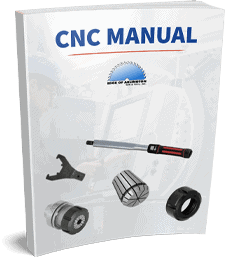
Free! EOASAW CNC Manual
Our free CNC Manual will guide you through selecting the right tool, maximizing machine time, finish, tool life & profits. Here we talk about tool materials and their uses.
- High speed steel (HSS). Used primarily on soft woods such as pine, aluminum, and soft plastics. HSS can be sharpened to a very sharp edge and at the appropriate hook and clearance angles “slices” through soft material, reducing pre-splitting. HSS is more impact resistant than carbide but is not wear resistant enough to hold up to many of today’s man-made materials.
- Tangtung (TG) A cast alloy material with a high tungsten content. Tangtung retains its hardness at very high temperatures, is more shock resistant than carbide, and resists corrosion from wood acids. Tangtung, like HSS, can be sharpened to a fine edge and is primarily used in hardwoods for a superior cross-grain cut. TG can and has been used in insert tooling for CNC applications. Freeborn Tool has a line of insert shaper cutters available in Tangtung. Tangtung is never recommended for manmade fiber boards or plywood.
- Carbide-tipped (CT). Used primarily on hard woods, laminates, composite materials, and for abrasive or resin-based products. Carbide is welded or brazed onto a steel body and profiled to the desired pattern; therefore it is the most common type of material used for profile and custom tooling. There are many different grades of carbide. The harder the grade of carbide, the more likely it is to break during the heating and cooling process in manufacturing—problems overcome with insert tooling.
- Solid carbide (SC). Used primarily on hard woods, wood composites, laminates, plastics, aluminum, and other composite materials for longer life and faster feed rates. Solid carbide can be cast into just about any shape. Solid Carbide rods are well-suited for making router bits with spiral geometries and small form or profile tools. Solid carbide blanks are also well-suited for insert tooling and are available in many standard sizes and configurations. Solid carbide is very wear resistant but not impact resistant—strain and deflection often lead to tool breakage.
- Diamond (PCD). Polycrystalline diamond is primarily used on composite materials such as melamine. PCD diamond is extremely heat and wear resistant (100+ times carbide) but is not impact resistant, and in fact, it chips fairly easily. Materials must be free of all foreign matter and be homogenous in nature or tool damage may result. Machine condition and maintenance are vital to cost effectiveness. High initial cost but very low operating cost can make diamond tooling a very economical alternative. Diamond wafers are brazed on to a steel body and are not suited to small sizes.
- Insert tooling. Insert tooling can provide consistency in production. Using replaceable inserts instead of brazed-on-carbide allows you to maintain a constant diameter. Insert tooling is also able to utilize harder, more wear resistant carbide than traditional CT tooling. While very versatile in nature, the design does not lend itself well to small diameters due to the need to affix the insert with Gibbs and/or screws.
You may also be interested in reading our post on Factors to be Considered Before Selecting Your Tool.
For more, refer to our CNC Manual.
To peruse our online catalog or to place an order, visit EOASAW.com or call us at 817-461-7171.
Have any questions? Feel free to ask us in the comment section, give us a call, send us an email, or visit us on Facebook!
For more informative EOASAW blog posts, visit our main Blog Page.
